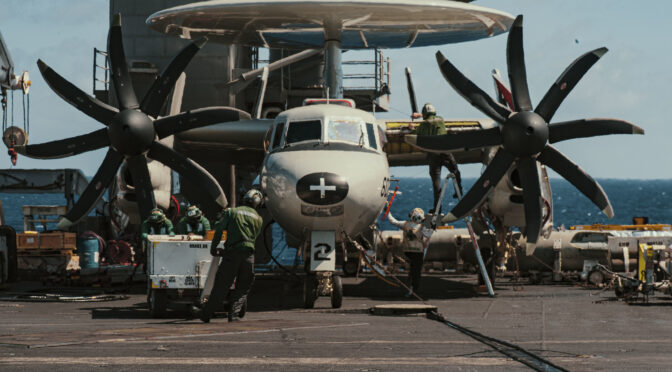By Dmitry Filipoff
CIMSEC recently featured a series of pieces submitted in response to our call for articles on naval intelligence.
Authors highlighted the valuable role naval intelligence plays in understanding the environment, conducting naval operations, and shaping force development. Naval intelligence will remain indispensable in understanding how competitors are operating and developing their forces, while also understanding their proclivities for aggression and destabilizing activities.
Yet naval intelligence has also been heavily shaped by years of focus on counterinsurgency and counterterrorism in the Middle East. Change is necessary to adapt to the challenges of great power competition, and to stay ahead of the curve of both ever more capable rivals and constantly evolving technology. Naval intelligence is poised to reap serious gains from artificial intelligence and machine learning, but the question of how to build trust remains. And even if naval intelligence reveals penetrating insight, will naval leadership and those in the other communities of the Navy be prepared to make full use of it?
Below are the authors who featured during CIMSEC’s naval intelligence topic week. We thank them for their excellent contributions.
“Brains and Brown Shoes: Building a Better Naval Aviation Intelligence Officer,” by Lieutenant Peter McGee, Lieutenant Gretchen Arndt, and Commander Christopher Nelson
“Intelligence support to naval aviation will not only require a re-assessment of manning, training, and equipping but a re-evaluation of how we provide tactical and operational intelligence support to the fleet. A promising roadmap for reform lies in the EA-18G Growler squadrons of the electronic attack community.”
“Intel Owns Red: How Red Teaming Can Prepare the Fleet for the Fight Ahead,” by Lieutenant Commander Christopher Blake and Lieutenant Grace Jones
“The most effective way to reinvigorate NAVINTEL’s focus on owning Red comes via two main methods: deep understanding of the adversary and the application of structured contrarian analysis. We describe these combined phenomena as Red Teaming, a two-pronged analytical methodology that can and should be applied at all levels of war.”
“The Coastwatchers: Intelligence Lessons Learned for the Future Single Naval Battle,” by Captain Michael Van Liew
“The historic success of the Coastwatchers provides valuable insight for naval intelligence in the future single naval battle. Proactive intelligence, multi-domain intelligence, and local access and support remain necessary for an effective naval intelligence operation.”
“Calling in Thunder: Naval Intelligence Enabling Precision Long-Range Fires,” by Lieutenant Commander Gerie Palanca
“In the long-range fight, rapid, actionable, targetable information is now the center of gravity. For the NIWC to execute an ISR construct that supports this evolving nature of warfare effectively, the community will need to develop a tailored artificial intelligence (AI) capability. Scouting in support of maritime fires is a culture shift for the NIWC, but it is not the only change that needs to happen.”
“Trustable AI: A Critical Challenge for Naval Intelligence,” by Stephen L. Dorton and Samantha Harper
“One can readily imagine numerous applications for AI/ML in naval intelligence at tactical, operational, and strategic levels: threat detection and tipping and cueing from signals intelligence (SIGINT) or electronic intelligence (ELINT), target classification with acoustic intelligence (ACINT) or imagery intelligence, using AI/ML to predict enemy movements for anti-submarine warfare, and many others.”
“The Unique Intelligence Challenges of Countering Naval Asymmetric Warfare,” by CDR (ret.) Dr. Eyal Pinko
“A better understanding of the nature of asymmetric naval warfare and its associated force development could have better prepared the Israeli Navy for this attack. However, naval asymmetric warfare poses unique complexities that can strain the ability of naval intelligence to comprehend it.”
“Connecting Partnerships for the Co-Production of Full-Spectrum Threat Intelligence,” by Hal Kempfer and John P. Sullivan
“In the maritime domain, the new role of naval intelligence will need to construct a program of genuine fusion or fusion centers that are integrated, capable and focused. This is not to simply ‘recreate the wheel’ but take what is already there and vastly improve upon it to integrated effort and management.”
“Old Books, New Ideas: Realigning Naval Intelligence for Great Power Competition,” by Matt Wertz
“Naval Intelligence will prove its relevance by maintaining its wartime footing daily through the experiences and insights that its competitors do not have. Naval Intelligence is the decision advantage for GPC, using ‘old school’ tools, honed through combat, the Cold War, and combat again, supplemented by “new school” techniques. All of these tools will be that decisive advantage just in case ‘competition’ becomes ‘combat.'”
“If You Build It, They Will Lose: Competing with China Requires New Information Warfare Tools,” by Andrew Thompson
“China’s modernization of its Navy, enhanced with its desired use of Artificial Intelligence (AI), should catalyze change in our own development efforts. Its modernization initiative directly supports its system destruction warfare principle, which operationalizes a system of systems approach to combat. Confronting this style of warfare requires a new mindset, and the Information Warfare apparatus, of which Naval Intelligence is an integral part, must align itself appropriately to support this change.”
Dmitry Filipoff is CIMSE’s Director of Online Content. Contact him at Content@cimsec.org.
Featured Image: PACIFIC OCEAN (March 1, 2021) Sailors conduct maintenance on the wing of an E-2C Hawkeye, assigned to the “Liberty Bells” of Airborne Command and Control Squadron (VAW) 115, on the flight deck of the aircraft carrier USS Theodore Roosevelt (CVN 71) March 1, 2021. (U.S. Navy photo by Mass Communication Specialist Seaman Alexander Williams)

